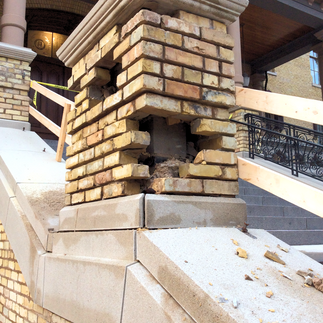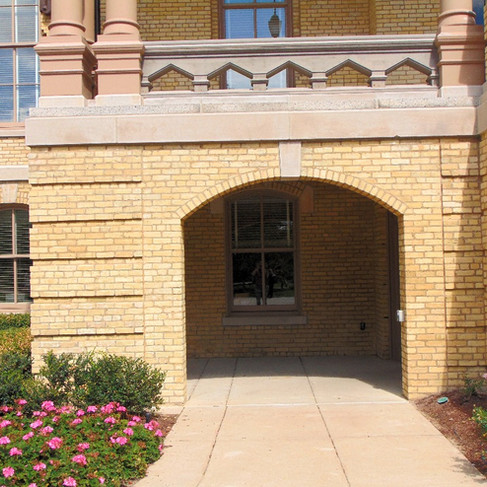Preservations and Restorations: Understanding the Challenges, and the Need for Brick Matching
- Masonry Cosmetics

- Jul 10, 2023
- 4 min read
Historical restorations preserve the architectural, aesthetic and historic character of a community or area. Over the years, even brick buildings may need a refresh after years of aging. There are some challenges that restoration companies run into during the preservation process that can cause major headaches. Masonry Cosmetics can help with one of the largest challenges facing historical restorations - matching brick.

The Need for Masonry Preservation and Restorations
Brick buildings are considered strong, stable and durable. As strong as these buildings are, they still need to be maintained after long periods of aging. As external temperatures change, for example, brick expands when heated and contracts when cooled. And beyond just brick, mortar and many other materials also make up the wall system. Preservation and restoration can make all the difference for these buildings as they age over time.
In most cases, brick will outlast the mortar joint itself, so a crucial part of preserving the building is repointing the mortar as needed. Usually, an entire building will not require repointing. Only designated areas of wear need to be addressed. Thankfully, it’s simpler to repoint mortar than it is to replace broken brick.
Cracked brick running down a wall indicates the building may have settled. An engineer’s involvement is necessary to discover a solution, and a restoration project must be planned in detail.

Three signs you need to repair brick and other masonry: Spalling, cracking, bowing
The Challenges
The masonry industry is made up of incredible architects, engineers, and restoration and masonry contractors, who do amazing work restoring our aging buildings.
Surprisingly, our toughest challenge is not the construction phase, but the visible aesthetics when a restoration job is complete. This can be difficult to achieve because of the limited options for an acceptable match or repair. Several brick plants that produced millions of brick in earlier years are no longer in operation. This makes it difficult or sometimes impossible to locate an identical brick to use for repairs.
Sometimes a brick stain is required, as well. One that withstands the test of time that neither harms nor compromises a brick in any way is needed now more than ever. And with all the misinformation that is out there, selecting the right stain requires a deeper dive.
Matching Bricks for Restorations
If the brick is no longer available, there are three simple steps to find a donor brick:
1. Find the closest brick in size and texture.
2. Get as close as you can to the base color of the brick.
3. Mortar plays just as important a role as the brick. If the brick is modular in size (2 1/4 x 7 5/8), mortar can represent as much as 18 to 20% of the wall area. This will, in turn, have a major effect on the color match. Matching the mortar color, texture, and the type of joint that is on your building will make a tremendous difference in quality and appearance.
Brick Staining: The Solution to Help Match Brick
When restoring a building to it's original beauty, and the original brick is no longer available, sometimes finding a brick similar just isn't close enough.
The Masonry Cosmetics brick staining natural solution will not hurt the brick and is long-lasting and low maintenance. Our brick staining products are formulated to penetrate the brick without changing the texture, creating a natural look that can enhance the beauty of your brickwork. We use a special blend of pigments and dyes that are designed to resist fading and weathering to keep your brick looking new for years to come.

The Masonry Cosmetics brick staining product is translucent, and does not seal or create a layer to the brick. The brick stain is proven to never peel, blister or crack.
The key to long-lasting masonry staining is absorption. The brick stain penetrates the pore structure of each brick and bonds to it. Once the bonding process is complete, the brick will look natural, whether the wall is wet or dry, and the stain will not create a sheen when wet.
A Brick Staining Success Story: The University of Notre Dame Golden Dome
The Golden Dome, or Main Building as it is called on campus, was built in 1879, and is a must-see destination and a popular place for picture taking. The building was beginning to show the effects of weather over the years. When restoration began on the Administration Building in 2015, it would have been difficult to find replacement brick needed for the project. It was unlikely that the brick created in the 1800s from clay at Notre Dame could be easily matched.
Wisely, they had saved brick from a previous deconstruction. That brick was close in size and texture, but not all of it matched the color of the original brick of the Main Building. As a result, the university hired Masonry Cosmetics to match masonry color by staining brick, mortar and limestone bands.
This masonry staining project under the University of Notre Dame Golden Dome was very successful, to everyone’s great satisfaction. Brick staining helped accomplish the high-quality result: beautifying one of America’s truly prestigious buildings. The end results:

Interested in masonry staining for historical preservations and restorations?
The stain product you select for either the brick or mortar is a critical part of long-term performance, and knowledge of the different stain products that are in the marketplace today will be key to the success of a lasting solution. Stay alert for misinformation. A few products that call themselves a proprietary brick stain may only consist of watered-down paint products. While the product may tout great technical data, lab tests, and support information, it may not have long-lasting field performance to support such claims.
Contact the Masonry Cosmetics masonry staining experts to start your project today!















Comments